
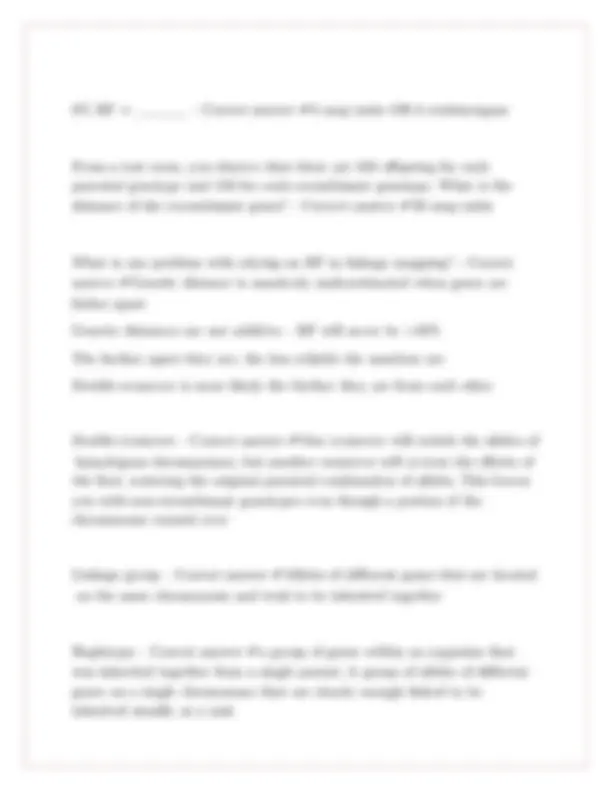
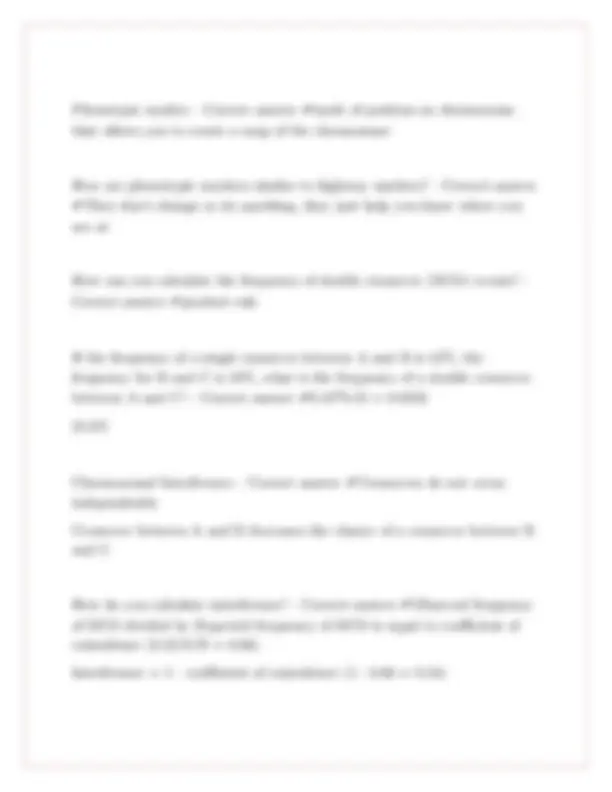
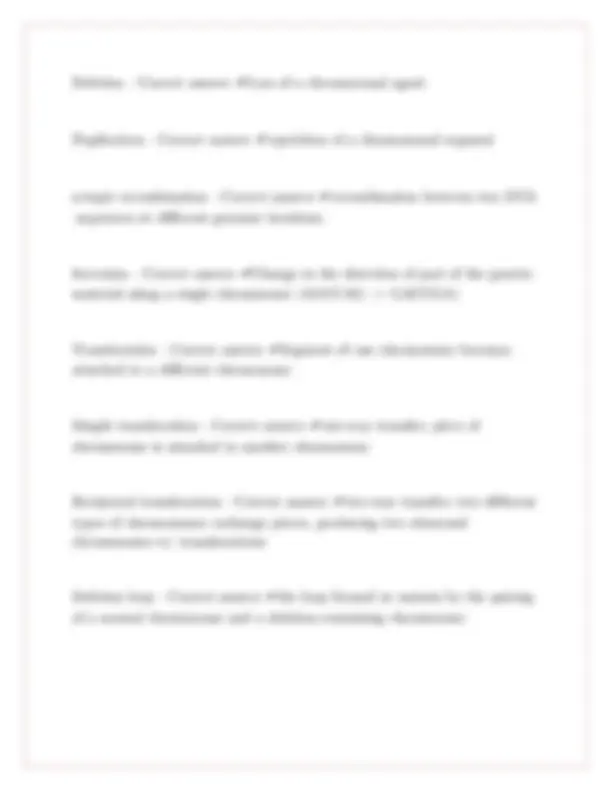
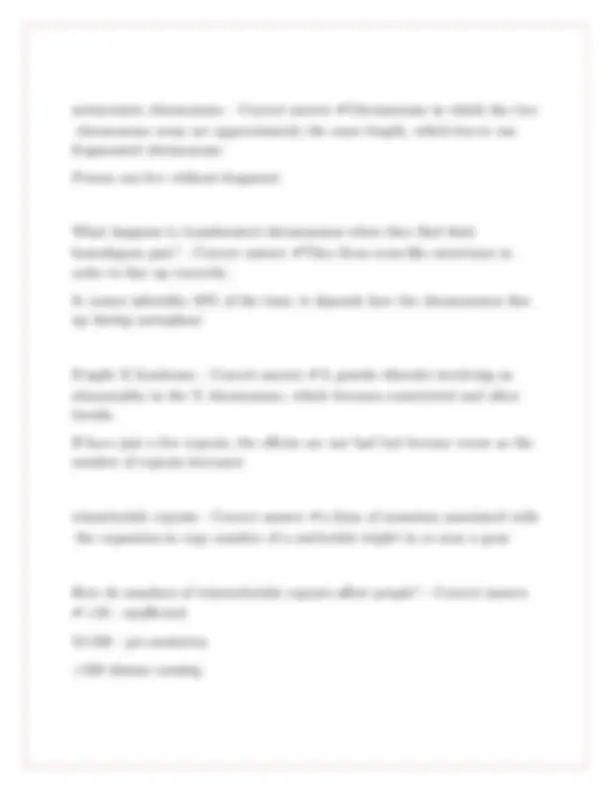
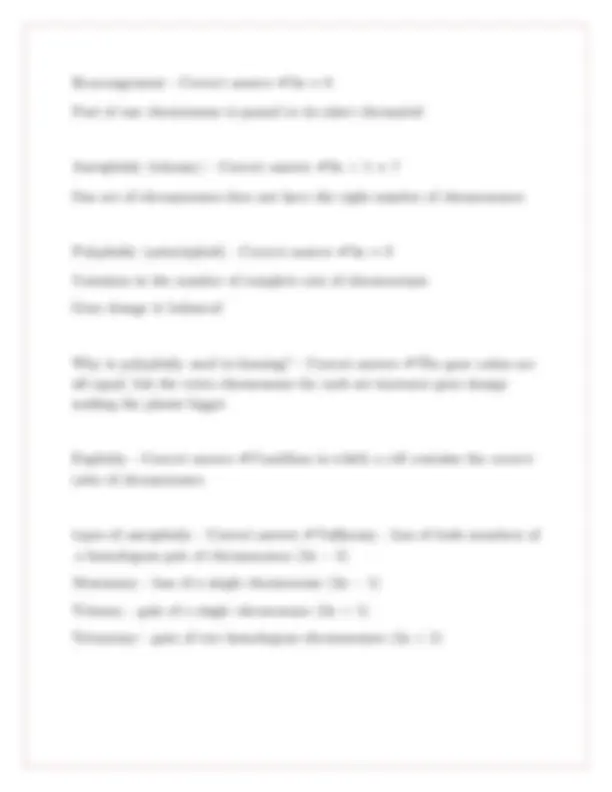
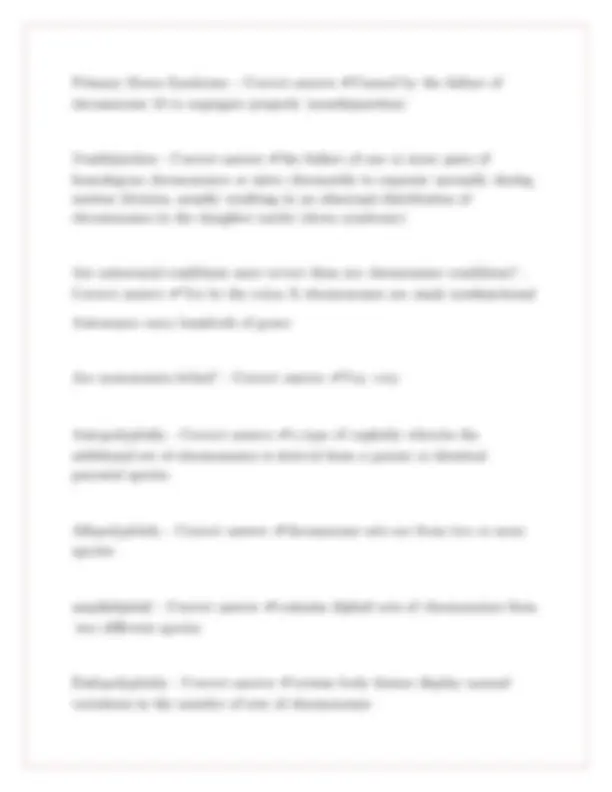
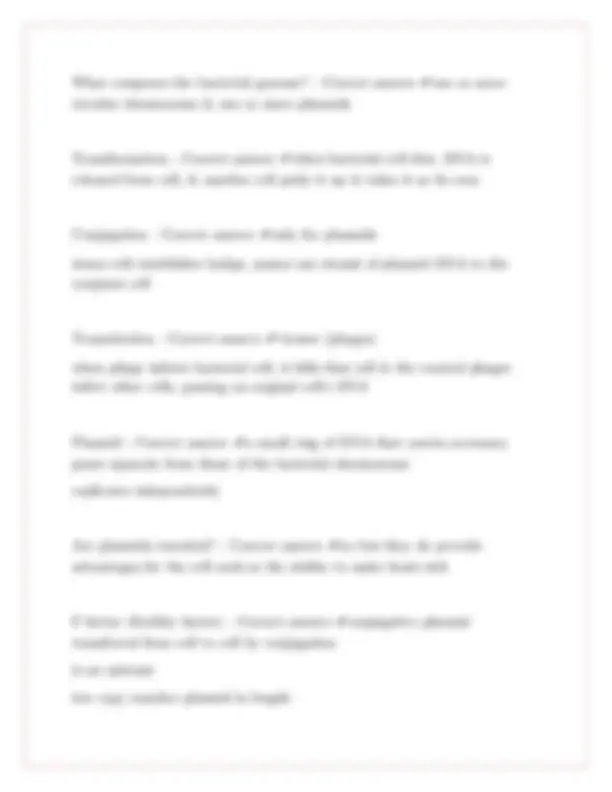
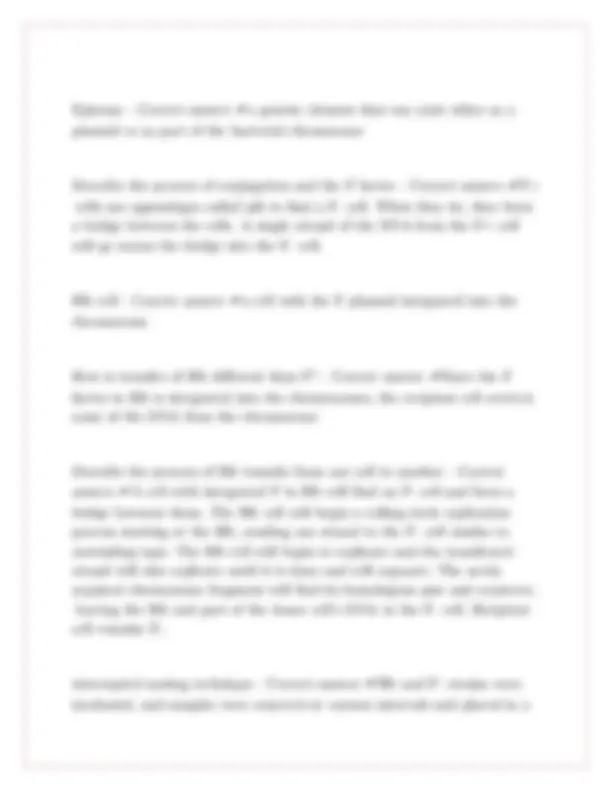
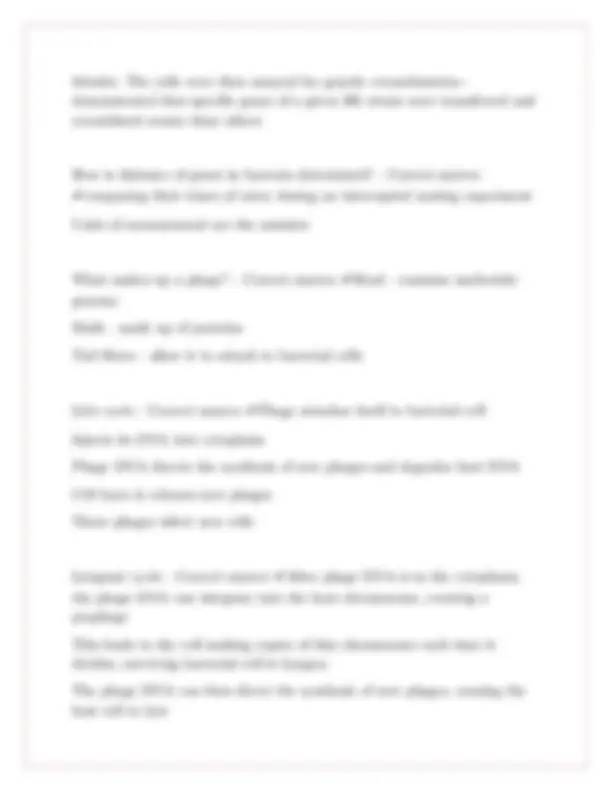
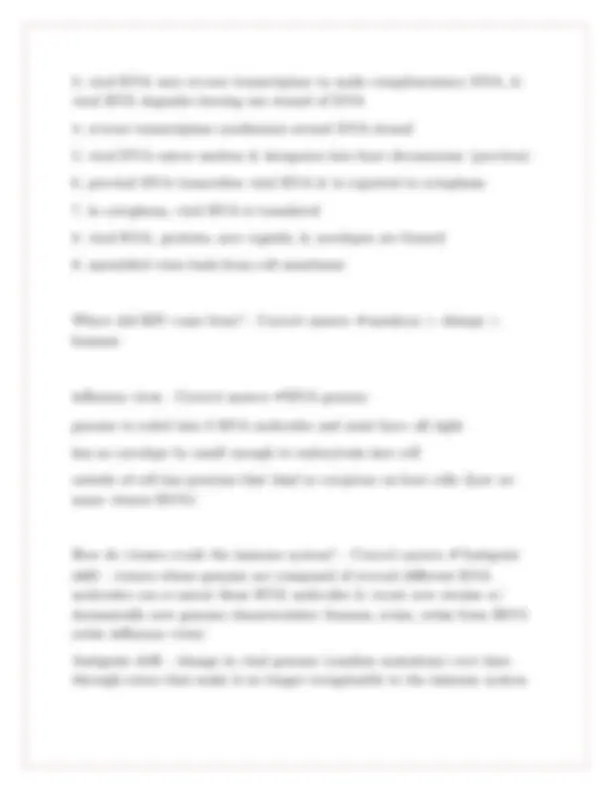


Study with the several resources on Docsity

Earn points by helping other students or get them with a premium plan


Prepare for your exams
Study with the several resources on Docsity

Earn points to download
Earn points by helping other students or get them with a premium plan
Community
Ask the community for help and clear up your study doubts
Discover the best universities in your country according to Docsity users
Free resources
Download our free guides on studying techniques, anxiety management strategies, and thesis advice from Docsity tutors
BIO 235 Exam 2 with precise detailed solutions
Typology: Exams
1 / 18

This page cannot be seen from the preview
Don't miss anything!











Independent |! assortment |! - |! Correct |! answer |! ✔Genes |! assort |! independently |! of |! each |! other |! when |! they |! are |! on |! opposite |! chromosomes Linkage |! - |! Correct |! answer |! ✔Two |! genes |! on |! a |! single |! pair |! of |! homologs; |! exchange |! occurs |! between |! two |! non-sister |! chromatids Chiasmata |! - |! Correct |! answer |! ✔Location |! of |! exchange |! of |! information |! between |! chromatids when |! does |! crossing |! over |! occur? |! - |! Correct |! answer |! ✔prophase |! I |! of |! meiosis How |! often |! does |! recombination |! occur? |! - |! Correct |! answer |! ✔Very |! frequently What |! determines |! how |! often |! genes |! will |! cross |! over? |! - |! Correct |! answer |! ✔Their |! distance |! from |! one |! another. |! The |! closer |! they |! are, |! the |! less |! likely |! they |! are |! to |! cross |! over. What |! does |! it |! mean |! when |! genes |! are |! linked? |! - |! Correct |! answer |! ✔they |! are |! on |! the |! same |! chromosome; |! assort |! independently
Describe |! how |! geneticists |! detect |! linkage |! of |! a |! gene |! - |! Correct |! answer |! ✔1. |! Select |! true-breeding |! lines |! that |! are |! homozygous |! dominant |! for |! one |! trait |! & |! homozygous |! recessive |! for |! the |! other |! trait |! (ygr |! ANL |! / |! ygr |! ANL |! & |! YGR |! anl |! / |! YGR |! anl). |! Parents |! produce |! dihybrid |! F1 |! population |! (ygr |! ANL |! / |! YGR |! anl)
Phenotypic |! marker |! - |! Correct |! answer |! ✔mark |! of |! position |! on |! chromosome |! that |! allows |! you |! to |! create |! a |! map |! of |! the |! chromosome How |! are |! phenotypic |! markers |! similar |! to |! highway |! markers? |! - |! Correct |! answer |! ✔They |! don't |! change |! or |! do |! anything, |! they |! just |! help |! you |! know |! where |! you |! are |! at How |! can |! you |! calculate |! the |! frequency |! of |! double |! crossover |! (DCO) |! events? |! - |! Correct |! answer |! ✔product |! rule If |! the |! frequency |! of |! a |! single |! crossover |! between |! A |! and |! B |! is |! 12%, |! the |! frequency |! for |! B |! and |! C |! is |! 18%, |! what |! is |! the |! frequency |! of |! a |! double |! crossover |! between |! A |! and |! C? |! - |! Correct |! answer |! ✔0.18*0.12 |! = |! 0. 21.6% Chromosomal |! Interference |! - |! Correct |! answer |! ✔Crossovers |! do |! not |! occur |! independently Crossover |! between |! A |! and |! B |! decreases |! the |! chance |! of |! a |! crossover |! between |! B |! and |! C How |! do |! you |! calculate |! interference? |! - |! Correct |! answer |! ✔Observed |! frequency |! of |! DCO |! divided |! by |! Expected |! frequency |! of |! DCO |! is |! equal |! to |! coefficient |! of |! coincidence |! (0.52/0.79 |! = |! 0.66) Interference |! = |! 1 |! - |! coefficient |! of |! coincidence |! (1 |! - |! 0.66 |! = |! 0.34)
Deletion |! - |! Correct |! answer |! ✔Loss |! of |! a |! chromosomal |! agent Duplication |! - |! Correct |! answer |! ✔repetition |! of |! a |! chromosomal |! segment ectopic |! recombination |! - |! Correct |! answer |! ✔recombination |! between |! two |! DNA |! sequences |! at |! different |! genomic |! locations. Inversion |! - |! Correct |! answer |! ✔Change |! in |! the |! direction |! of |! part |! of |! the |! genetic |! material |! along |! a |! single |! chromosome |! (AGCCAG |! -> |! GACCGA) Translocation |! - |! Correct |! answer |! ✔Segment |! of |! one |! chromosome |! becomes |! attached |! to |! a |! different |! chromosome Simple |! translocation |! - |! Correct |! answer |! ✔one-way |! transfer; |! piece |! of |! chromosome |! is |! attached |! to |! another |! chromosome Reciprocal |! translocation |! - |! Correct |! answer |! ✔two-way |! transfer; |! two |! different |! types |! of |! chromosomes |! exchange |! pieces, |! producing |! two |! abnormal |! chromosomes |! w/ |! translocations Deletion |! loop |! - |! Correct |! answer |! ✔the |! loop |! formed |! at |! meiosis |! by |! the |! pairing |! of |! a |! normal |! chromosome |! and |! a |! deletion-containing |! chromosome
Results |! in |! two |! normal |! chromosomes, |! one |! with |! two |! centromeres, |! and |! one |! with |! no |! centromeres What |! happens |! to |! the |! two |! abnormal |! chromosomes |! from |! pericentric |! inversion? |! - |! Correct |! answer |! ✔The |! chromosome |! with |! no |! centromere |! will |! be |! lost |! bc |! the |! spindle |! fibers |! have |! nothing |! to |! grab |! hold |! of The |! chromosome |! with |! 2 |! centromeres |! will |! break |! because |! one |! spindle |! fiber |! will |! grab |! it |! from |! one |! end |! and |! another |! from |! the |! opposite |! end, |! playing |! tug |! of |! war What |! happens |! when |! inverted |! chromosomes |! crossover? |! - |! Correct |! answer |! ✔They |! do |! not |! crossover |! equally, |! leaving |! one |! part |! of |! the |! chromosome |! without |! a |! centromere. |! That |! chromosome |! is |! lost |! bc |! it |! has |! no |! centromere. Dicentric |! chromosomes |! lead |! to |! dicentric |! bridges dicentric |! bridge |! - |! Correct |! answer |! ✔Structure |! produced |! when |! the |! two |! centromeres |! of |! a |! dicentric |! chromatid |! are |! pulled |! toward |! opposite |! poles, |! stretching |! the |! dicentric |! chromosome |! across |! the |! center |! of |! the |! nucleus. |! Eventually, |! the |! dicentric |! bridge |! breaks |! as |! the |! two |! centromeres |! are |! pulled |! apart. What |! causes |! Familial |! Down-Syndrome? |! - |! Correct |! answer |! ✔Translocation |! of |! q |! are |! of |! chromosome |! 21 |! (q-) |! is |! translocated |! to |! chromosome |! 10 |! or |! 14 |! (q+). |! This |! causes |! there |! to |! be |! three |! ends |! of |! chromosome |! 21, |! which |! heavily |! affects |! gene |! dosage. Translocation |! carrier |! - |! Correct |! answer |! ✔Individual |! organism |! heterozygous |! for |! a |! chromosome |! translocation
metacentric |! chromosome |! - |! Correct |! answer |! ✔Chromosome |! in |! which |! the |! two |! chromosome |! arms |! are |! approximately |! the |! same |! length, |! which |! leaves |! one |! fragmented |! chromosome. |! Person |! can |! live |! without |! fragment. What |! happens |! to |! translocated |! chromosomes |! when |! they |! find |! their |! homologous |! pair? |! - |! Correct |! answer |! ✔They |! form |! cross-like |! structures |! in |! order |! to |! line |! up |! correctly. It |! causes |! infertility |! 50% |! of |! the |! time; |! it |! depends |! how |! the |! chromosomes |! line |! up |! during |! metaphase Fragile |! X |! Syndrome |! - |! Correct |! answer |! ✔A |! genetic |! disorder |! involving |! an |! abnormality |! in |! the |! X |! chromosome, |! which |! becomes |! constricted |! and |! often |! breaks. If |! have |! just |! a |! few |! repeats, |! the |! effects |! are |! not |! bad |! but |! become |! worse |! as |! the |! number |! of |! repeats |! increases trinucleotide |! repeats |! - |! Correct |! answer |! ✔a |! form |! of |! mutation |! associated |! with |! the |! expansion |! in |! copy |! number |! of |! a |! nucleotide |! triplet |! in |! or |! near |! a |! gene How |! do |! numbers |! of |! triunucleotide |! repeats |! affect |! people? |! - |! Correct |! answer |! ✔<50 |! - |! unaffected 55-230 |! - |! pre-mutation
230 |! disease |! causing
Primary |! Down |! Syndrome |! - |! Correct |! answer |! ✔Caused |! by |! the |! failure |! of |! chromosome |! 21 |! to |! segregate |! properly |! (nondisjunction) Nondisjuction |! - |! Correct |! answer |! ✔the |! failure |! of |! one |! or |! more |! pairs |! of |! homologous |! chromosomes |! or |! sister |! chromatids |! to |! separate |! normally |! during |! nuclear |! division, |! usually |! resulting |! in |! an |! abnormal |! distribution |! of |! chromosomes |! in |! the |! daughter |! nuclei |! (down |! syndrome) Are |! autosomal |! conditions |! more |! severe |! than |! sex |! chromosome |! conditions? |! - |! Correct |! answer |! ✔Yes |! bc |! the |! extra |! X |! chromosomes |! are |! made |! nonfunctional Autosomes |! carry |! hundreds |! of |! genes Are |! monosomies |! lethal? |! - |! Correct |! answer |! ✔Yes, |! very Autopolyploidy |! - |! Correct |! answer |! ✔a |! type |! of |! euploidy |! wherein |! the |! additional |! set |! of |! chromosomes |! is |! derived |! from |! a |! parent |! or |! identical |! parental |! species Allopolyploidy |! - |! Correct |! answer |! ✔chromosome |! sets |! are |! from |! two |! or |! more |! species amphidiploid |! - |! Correct |! answer |! ✔contains |! diploid |! sets |! of |! chromosomes |! from |! two |! different |! species Endopolyploidy |! - |! Correct |! answer |! ✔certain |! body |! tissues |! display |! normal |! variations |! in |! the |! number |! of |! sets |! of |! chromosomes
diploid |! animals |! sometimes |! produce |! tissues |! that |! are |! polyploid What |! generates |! autopoplyploids? |! - |! Correct |! answer |! ✔complete |! mitotic |! nondisjunction |! in |! mitosis Complete |! mitotic |! nondisjunction |! - |! Correct |! answer |! ✔sister |! chromatids |! separate, |! but |! will |! not |! be |! pulled |! in |! separate |! daughter |! nuclei, |! they |! end |! up |! in |! the |! same |! nucleus |! as |! independent |! chromosomes 4n What |! is |! the |! purpose |! of |! colchicine? |! - |! Correct |! answer |! ✔Causes |! failure |! of |! anaphase |! by |! blocking |! activity |! of |! spindle |! fibers, |! causing |! complete |! nondisjunction Used |! in |! plants |! to |! increase |! gene |! expression Triploids |! - |! Correct |! answer |! ✔Having |! three |! complete |! sets |! of |! chromosomes comes |! from |! one |! diploid |! gamete |! & |! one |! haploid |! gamete Are |! polyploids |! sterile |! or |! not? |! - |! Correct |! answer |! ✔Sterile |! bc |! odd |! number |! of |! chromosome |! sets |! produce |! unbalanced |! gametes, |! which |! leads |! to |! imbalance |! of |! gene |! dosage Why |! are |! allodiploids/allopolyploids |! infertile? |! - |! Correct |! answer |! ✔When |! distantly |! related |! species |! produce |! offspring, |! many |! or |! all |! of |! their |! chromosomes |! fail |! to |! find |! a |! homologue |! or |! segregate |! properly |! and |! produce |! unbalanced |! gametes
What |! composes |! the |! bacterial |! genome? |! - |! Correct |! answer |! ✔one |! or |! more |! circular |! chromosome |! & |! one |! or |! more |! plasmids Transformation |! - |! Correct |! answer |! ✔when |! bacterial |! cell |! dies, |! DNA |! is |! released |! from |! cell, |! & |! another |! cell |! picks |! it |! up |! & |! takes |! it |! as |! its |! own Conjugation |! - |! Correct |! answer |! ✔only |! for |! plasmids donor |! cell |! establishes |! bridge, |! passes |! one |! strand |! of |! plasmid |! DNA |! to |! the |! recipient |! cell Transduction |! - |! Correct |! answer |! ✔viruses |! (phages) when |! phage |! infects |! bacterial |! cell, |! it |! kills |! that |! cell |! & |! the |! created |! phages |! infect |! other |! cells, |! passing |! on |! original |! cell's |! DNA Plasmid |! - |! Correct |! answer |! ✔a |! small |! ring |! of |! DNA |! that |! carries |! accessory |! genes |! separate |! from |! those |! of |! the |! bacterial |! chromosome replicates |! independently Are |! plasmids |! essential? |! - |! Correct |! answer |! ✔no |! but |! they |! do |! provide |! advantages |! for |! the |! cell |! such |! as |! the |! ability |! to |! make |! hosts |! sick F |! factor |! (fertility |! factor) |! - |! Correct |! answer |! ✔conjugative |! plasmid |! transferred |! from |! cell |! to |! cell |! by |! conjugation is |! an |! episome low |! copy |! number |! plasmid |! in |! length
Episome |! - |! Correct |! answer |! ✔a |! genetic |! element |! that |! can |! exist |! either |! as |! a |! plasmid |! or |! as |! part |! of |! the |! bacterial |! chromosome Describe |! the |! process |! of |! conjugation |! and |! the |! F |! factor |! - |! Correct |! answer |! ✔F+ |! cells |! use |! appendages |! called |! pili |! to |! find |! a |! F- |! cell. |! When |! they |! do, |! they |! form |! a |! bridge |! between |! the |! cells. |! A |! single |! strand |! of |! the |! DNA |! from |! the |! F+ |! cell |! will |! go |! across |! the |! bridge |! into |! the |! F- |! cell. Hfr |! cell |! - |! Correct |! answer |! ✔a |! cell |! with |! the |! F |! plasmid |! integrated |! into |! the |! chromosome How |! is |! transfer |! of |! Hfr |! different |! than |! F? |! - |! Correct |! answer |! ✔Since |! the |! F |! factor |! in |! Hfr |! is |! integrated |! into |! the |! chromosomes, |! the |! recipient |! cell |! receives |! some |! of |! the |! DNA |! from |! the |! chromosome Describe |! the |! process |! of |! Hfr |! transfer |! from |! one |! cell |! to |! another |! - |! Correct |! answer |! ✔A |! cell |! with |! integrated |! F |! in |! Hfr |! will |! find |! an |! F- |! cell |! and |! form |! a |! bridge |! between |! them. |! The |! Hfr |! cell |! will |! begin |! a |! rolling-circle |! replication |! process |! starting |! at |! the |! Hfr, |! sending |! one |! strand |! to |! the |! F- |! cell |! similar |! to |! unwinding |! tape. |! The |! Hfr |! cell |! will |! begin |! to |! replicate |! and |! the |! transferred |! strand |! will |! also |! replicate |! until |! it |! is |! done |! and |! will |! separate. |! The |! newly |! acquired |! chromosome |! fragment |! will |! find |! its |! homologous |! pair |! and |! crossover, |! leaving |! the |! Hfr |! and |! part |! of |! the |! donor |! cell's |! DNA |! in |! the |! F- |! cell. |! Recipient |! cell |! remains |! F-. interrupted |! mating |! technique |! - |! Correct |! answer |! ✔Hfr |! and |! F- |! strains |! were |! incubated, |! and |! samples |! were |! removed |! at |! various |! intervals |! and |! placed |! in |! a |!
Virulent |! phages |! - |! Correct |! answer |! ✔reproduce |! strictly |! through |! the |! lytic |! cycle |! and |! always |! kill |! their |! host |! cells Temperate |! phages |! - |! Correct |! answer |! ✔phages |! that |! use |! both |! the |! lytic |! and |! lysogenic |! cycles Generalized |! transducing |! phage |! p1 |! - |! Correct |! answer |! ✔cuts |! bacterial |! chromosome |! into |! pieces |! and |! can |! package |! bacterial |! DNA |! into |! phage |! particles generalized |! transducing |! phage |! - |! Correct |! answer |! ✔transfers |! DNA |! derived |! from |! any |! part |! of |! the |! bacterial |! chromosome specialized |! transducing |! phage |! - |! Correct |! answer |! ✔transfers |! genes |! from |! a |! particular |! region |! of |! the |! bacterial |! chromosome contransduction |! - |! Correct |! answer |! ✔probability |! of |! two |! markers |! being |! transduced |! simultaneously Natural |! transformation |! - |! Correct |! answer |! ✔DNA |! uptake |! occurs |! without |! outside |! help artificial |! transformation |! - |! Correct |! answer |! ✔DNA |! uptake |! occurs |! with |! the |! help |! of |! special |! techniques
Retroviruses |! - |! Correct |! answer |! ✔use |! reverse |! transcriptase |! to |! copy |! their |! RNA |! genome |! into |! host |! genome |! (HIV, |! SIV) RNA |! to |! RNA |! - |! Correct |! answer |! ✔replication |! of |! RNA |! viruses |! (COVID-19) RNA-dependent |! & |! RNA |! polymerase DNA |! to |! DNA |! - |! Correct |! answer |! ✔chromosomal |! replication DNA-dependent |! & |! DNA |! polymerase DNA |! to |! RNA |! - |! Correct |! answer |! ✔gene |! transcription DNA-dependent |! & |! RNA |! polymerase |! (most |! common) RNA |! to |! DNA |! - |! Correct |! answer |! ✔retroviral |! insertion |! in |! genome RNA-dependent |! & |! DNA |! polymerase Structure |! of |! retrovirus |! - |! Correct |! answer |! ✔Viral |! protein |! coat |! (capsid) |! - |! houses |! two |! copies |! of |! RNA |! genome |! and |! reverse |! transcriptase |! enzyme Core-shell |! proteins |! - |! surrounds |! capsid Viral-envelope |! glycoprotein |! - |! has |! important |! proteins |! that |! must |! recognize |! certain |! receptors |! in |! cells infection |! cycle |! of |! retrovirus |! - |! Correct |! answer |! ✔1. |! virus |! attaches |! to |! host |! cell |! at |! receptors |! in |! the |! membrane